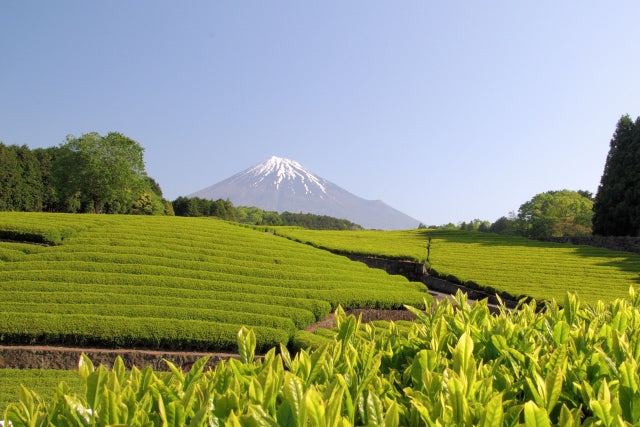
Vol. 3 The Many Types of Japanese Tea Exploring the Depth in Every Cup
Share
The Japanese tea we enjoy every day comes in a remarkable variety of styles.
Although all teas are made from the same plant—the Camellia sinensis, or cha no ki—differences in cultivation and processing bring out completely unique aromas and flavors.
Let’s take a closer look at some of the main types of Japanese tea.

The Foundation: Steamed Green Tea
Broadly speaking, teas can be divided into three categories: unfermented (green tea), semi-fermented (oolong tea), and fermented (black tea).
Japanese tea is primarily steamed green tea, known as mushi-sei ryokucha. By steaming the freshly picked leaves immediately after harvest, oxidation is halted, preserving their bright green color and refreshing aroma.
Types of Steamed Green Tea
Sencha (煎茶)
Sencha is the most common type of Japanese tea, accounting for about 70% of total production.
Depending on the steaming time, it is classified as asamushi (lightly steamed), chūmushi (medium-steamed), or fukamushi (deep-steamed).
Lightly steamed teas have a clear, golden-green color and a crisp taste, while deep-steamed teas—steamed two to three times longer—offer a deeper color and a richer flavor with less astringency.
Gyokuro (玉露)
Known as the “king of teas,” Gyokuro is a premium variety characterized by deep, rich umami and mellow sweetness.
About 20 days before harvest, the tea bushes are shaded with straw or black netting to block sunlight. This covered cultivation increases the amino acid theanine, enhancing umami and sweetness.
Gyokuro is famous for its thick, velvety mouthfeel and its distinctive ooika—a seaweed-like fragrance created by shading.
Kabusecha (かぶせ茶)
Kabusecha is made from tea leaves shaded with cloth or netting for about a week before harvest, then processed in the same way as Sencha.
Brewed slowly with cooler water, it has a refined, Gyokuro-like sweetness; brewed hotter, it offers a pleasant Sencha-like astringency.
Matcha (抹茶)
Matcha is made from tencha, tea leaves grown under shade like Gyokuro, then dried without rolling and finely ground in stone mills.
When whisked with a bamboo chasen as in the tea ceremony, Matcha reveals a delicate balance of umami and bitterness.
Because the entire leaf is consumed, it’s also rich in nutrients and now widely enjoyed in lattes, desserts, and beyond.
Teas with a Toasty Aroma
Hōjicha (ほうじ茶)
Made by roasting Sencha or Bancha over high heat until the leaves turn brown, Hōjicha has a warm, toasty fragrance and a mild, clean taste.
Low in caffeine, it’s gentle on the body—perfect for evenings or children.
Genmaicha (玄米茶)
Genmaicha is a blend of roasted brown rice and green tea—most commonly Bancha, though Sencha is also used. Its warm, nutty aroma and mild flavor make it especially satisfying after a meal. Variations with Sencha or even added Matcha offer different tastes, so each blend has its own unique character.
Regional and Characteristic Varieties
Bancha (番茶)
Made from larger, mature leaves picked later in the season, Bancha has a light and refreshing flavor.
It is commonly enjoyed as an everyday tea, especially in western Japan.
Fukamushi-cha (深蒸し茶)
Deep-steamed tea has a longer steaming process that softens bitterness and brings a dense, mellow flavor.
Shizuoka and Kakegawa are well-known regions for this style.
Kukicha or Bōcha (茎茶・棒茶)
Made from the stems of the tea plant, this tea is lightly sweet and fragrant.
The Kaga Bōcha from Ishikawa Prefecture is a famous example of this regional specialty.
Beyond Steamed Green Tea
Kama-iri-cha (釜炒り茶)
Produced mainly in Kyushu, Kama-iri-cha is made by pan-firing the leaves instead of steaming them—a method rooted in ancient Chinese tea-making.
This gives it a distinct aroma known as kamaka and a refreshing, slightly roasted flavor.
Japanese Oolong Tea
A semi-fermented tea now being produced in regions like Kagoshima and Shizuoka.
Compared to Chinese or Taiwanese oolong, Japanese oolong has a lighter body and a flavor closer to green tea.
Wakōcha (和紅茶) – Japanese Black Tea
Black tea production was first introduced to Japan over 100 years ago, during the Meiji era, and is now being rediscovered across the country.
Wakōcha tends to have a gentle sweetness and mild astringency—softer and more delicate than many imported black teas.
Enjoying Japanese Tea in Daily Life
Morning: Start your day with a refreshing cup of Sencha.
Afternoon: Take a quiet break with Gyokuro or Matcha.
After dinner: Relax with low-caffeine Hōjicha.
On weekends: Change things up with Kama-iri-cha or Wakōcha.
Choosing tea according to the time of day or your mood makes tea moments even more rewarding.
In Summary
Japanese tea continues to evolve—not only through steaming, but also roasting and fermentation.
Though all come from the same tea plant, each style reveals a completely different taste and aroma.
Once you discover this depth, even your everyday cup becomes more fascinating.
Next time you select tea leaves, try asking yourself:
“What kind of tea suits my mood today?”
